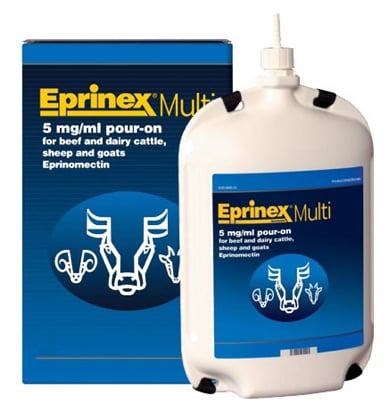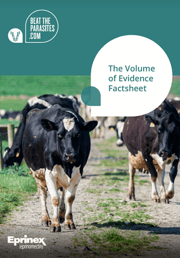EPRINEX Multi Pour-On was launched in 2017 and is licensed to treat dairying sheep and goats in addition to cattle. It was developed as a line extension of EPRINEX Pour-On, which was the first dairy and beef eprinomectin wormer with zero-milk withhold launched over 20 years ago.
Available in: 1L, 2.5L and 5L

http://www.cattleandsheepworming.com/en-ie/worms/lung-worm-dictyocaulus-viviparusTarget species - beef and dairy cattle
Target species - goats and sheep
Target species - beef and dairy cattle
Target species - goats and sheep
Cattle: 1ml/10kg
Sheep and Goats: 2ml/10kg
These tables are included as a guide - cattle, sheep and goats that fall between the weights listed should have their dose calculated appropriately.
|
EPRINEX Multi Pour-On Dose Guide for Cattle |
||||
|
Number of treatments per pack |
||||
|
Bodyweight |
Dose |
1L |
2.5L |
5L |
|
200kg |
20ml |
50 |
125 |
250 |
|
300kg |
30ml |
33 |
83 |
166 |
|
400kg |
40ml |
25 |
62 |
125 |
|
500kg |
50ml |
20 |
50 |
100 |
|
600kg |
60ml |
16 |
41 |
83 |
|
700kg |
70ml |
14 |
35 |
71 |
|
800kg |
80ml |
12 |
31 |
62 |
|
EPRINEX Multi Pour-On Dose Guide for Sheep & Goats |
||||
|
Number of treatments per pack |
||||
|
Bodyweight |
Dose |
1L |
2.5L |
5L |
|
10kg |
2ml |
500 |
1250 |
2500 |
|
20kg |
4ml |
250 |
624 |
1250 |
|
30kg |
6ml |
166 |
416 |
833 |
|
40kg |
8ml |
125 |
312 |
625 |
|
50kg |
10ml |
100 |
250 |
500 |
|
60kg |
12ml |
83 |
208 |
416 |
|
70kg |
14ml |
71 |
178 |
357 |
|
80kg |
16ml |
62 |
156 |
312 |
Cattle:
Meat and offal: 15 days.
Milk: zero hours.
Sheep:
Meat and offal: 2 days
Milk: zero hours
Goats:
Meat and offal: 1 day
Milk: zero hours
Cattle: Should be applied topically by pouring along the backline in a narrow strip extending from the withers to the tailhead.
Sheep: When administering the product along the backline, part the fleece/coat and place applicator nozzle or bottle spout against the skin.

Yes EPRINEX Multi Pour-On can be used in lactating cows and has a zero milk withdrawal so can be used at any stage of lactation.
EPRINEX Multi should be applied along the backline in a narrow strip extending from the withers to the tailhead. The dose should be measured using the measuring cup supplied or using an appropriate applicator gun. It is recommended to double check the calibration of these every time you apply the product.
Treatment around the time of calving will remove a cow’s gut worm burden and protect against re-infection during early lactation, optimising feed intake and energy balance during the transition period. The lactation-long benefits of removing gut worm at this time have been demonstrated, with cows shown to produce up to 2 litres more milk each day for the entire lactation1,2.
References
1. Reist, M., Forbes, A.B., Bonfanti, M., Beretta, W., Pfister, K., 2011, The effect of eprinomectin treatment on milk yield and quality in dairy cows in South Tyrol as related to gastro-intestinal nematodes. Vet Rec 168 : 484
2. Studies carried out using Eprinex Pour-on for Beef and Dairy Cattle (Eprinomectin), which has the same formulation as Eprinex Multi 5mg/ml, see HPRA, (2018) IPAR Eprinex Multi 5 mg/ml pour-on for beef
and dairy cattle, sheep and goats [online] Available at: https://www. hpra.ie/img/uploaded/swedocuments/Public_AR_VPA10454-034
001_07122018154613.pdf [Accessed 18 Feb 2019]
Whilst all efforts should be taken to treat cattle under optimal conditions, clinical evidence has demonstrated that EPRINEX Multi Pour-On is rainfast. In cattle, rainfall before, during or after the application of the product has been shown to have no impact on its efficacy. It has also been demonstrated that haircoat length has no impact on the product’s efficacy1,2.
References:
1. Studies carried out using Eprinex Pour-on for Beef and Dairy Cattle
(Eprinomectin), which has the same formulation as Eprinex Multi 5mg/ml, see HPRA, (2018) IPAR Eprinex Multi 5 mg/ml pour-on for beef
and dairy cattle, sheep and goats [online] Available at: https://www. hpra.ie/img/uploaded/swedocuments/Public_AR_VPA10454-034
001_07122018154613.pdf [Accessed 18 Feb 2019]
2. Gogolewski et al. (1997) Veterinary Parasitology 69:95-102
The MOO Test (Milk Ostertagia ostertagi ELISA) is a useful diagnostic tool in dairy herds. Where the level of exposure is determined to be high, Ostertagia is likely to be having a significant impact on productivity, and treatment of the herd is likely to yield an improvement in milk production.
The following information may only be viewed by veterinarians, SQPs/RPs or farmers.
Please confirm that you are eligible to view this information:
Yes I am a veterinarian, SQP/RP or farmer
Technical Services
For technical enquiries or to report an adverse event, please use the following contact details:
Ireland: +353 (0)1 291 3985
VetEnquiries@boehringer-ingelheim.com
Customer Support Centre
For marketing and general enquiries:
Ireland: +353 (0)1 291 3985
Further information available from Boehringer Ingelheim Animal Health UK Ltd, RG12 8YS, UK.
The steerhead logo is a registered trademark of the Boehringer Ingelheim Group.
© 2024 Boehringer Ingelheim Animal Health UK Ltd. All rights reserved. Date of preparation: Apr 2019. AHD11105.
Use Medicines Responsibly.